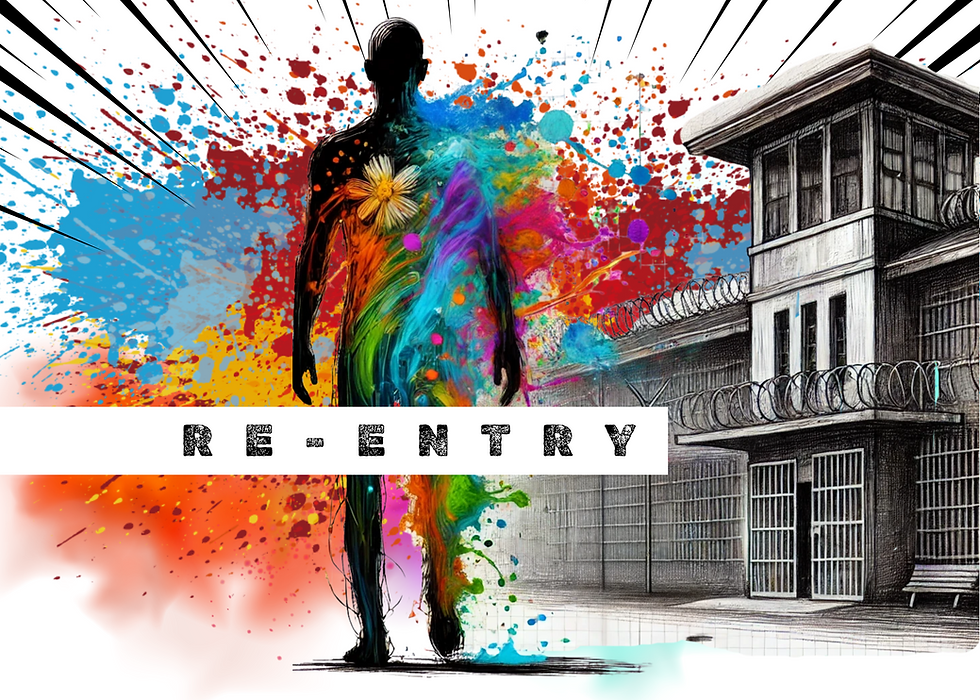Purpose Is the New Freedom
- Troy Rienstra

- May 12
- 5 min read
How Formerly Incarcerated People Are Redefining Success
We live in a country that measures people by their worst moments, then forgets to measure what they do after. We fixate on the failures, but we rarely take the time to examine the full picture—especially when that picture includes success.
The national recidivism rate in the United States remains high. According to the Bureau of Justice Statistics, approximately 68% of individuals released from state prisons are re-arrested within three years, and about 77% within five. That’s the story we hear the most.
But here’s the part that too often gets left out: nearly a quarter of formerly incarcerated individuals do not return to prison. Many of them go on to lead productive, purpose-driven lives, and some become leaders in their communities, shaping policy, business, art, and advocacy.
Those individuals deserve to be seen. Their success deserves to be acknowledged. Because it’s not just about avoiding recidivism—it’s about creating impact, building legacies, and breaking cycles for the generations coming behind them.
In communities across the nation, something powerful is unfolding. Men and women who once bore the label "felon" are now becoming business owners, educators, fathers and mothers, mentors, and civic leaders. Not because they were handed anything, but because they decided that freedom without purpose wasn’t enough.
This is about how purpose became the compass for a growing number of formerly incarcerated individuals who are not just rebuilding their lives — they are reshaping what success, leadership, and community contribution really look like.
There are so many conversations in this space about what doesn’t work — the barriers, the policies, the lack of support. But today, I want to take a moment to appreciate the dedication, discipline, and brilliance of so many formerly incarcerated individuals who are not only transforming their own lives, but also helping to transform the world around them.
These stories of growth and leadership aren’t rare. They’re just underreported. So let’s spotlight what happens when a person is given room to thrive — or more often, when they carve out that space for themselves.
Across the U.S. and beyond, returning citizens are creating change:
Coss Marte, founder of ConBody, turned his incarceration into a multimillion-dollar fitness and reentry model
Terrell Blount, executive director of the Formerly Incarcerated College Graduates Network, went from prison to Princeton and now helps others navigate higher education after release.
Valentino Dixon, wrongfully incarcerated for 27 years, now advocates for criminal justice reform through his internationally recognized art.
Andrew Fraser, a former high-profile Australian lawyer turned prisoner, now lectures on legal ethics and prison reform, using his lived experience to change systems.
Shaka Senghor, an author of "Writing My Wrongs" and thought leader who spent 19 years in prison, has spoken on TED stages and advised tech companies and philanthropy organizations on redemption, storytelling, and policy.
These are individuals who have become symbols of innovation, not because they had it easy, but because they chose clarity, consistency, and contribution.
They are redefining what post-prison success can look like. They are proving that potential doesn’t disappear behind bars — it evolves. These leaders are shaping schools, tech spaces, policy, the arts, and youth mentorship. And they’re doing it not out of a need for recognition, but out of a sense of purpose that runs deep.
The Data Doesn’t Lie
A 2021 Cornell University study found that formerly incarcerated individuals who participated in education and vocational programs while inside were 43% less likely to return to prison and significantly more likely to earn above-average wages post-release.
The RAND Corporation found that every $1 invested in prison education saves $5 in future incarceration costs. That's not just an economic argument — that's an argument for smarter justice.
According to the Brookings Institution, returning citizens are increasingly using "entrepreneurial thinking and personal resilience" to carve out successful futures, even without access to mainstream support systems.
"We must shift the narrative of reentry from managing risk to cultivating opportunity. The people closest to the pain are often the closest to the solution."— Brookings, 2022
Yet despite the growing evidence, our policies and media still center the fear of re-offense over the reality of transformation.
Leadership isn’t about titles or credentials—it’s about influence, direction, and the ability to create meaningful change. And some of the most effective, transformative leaders today are people who’ve returned from incarceration with clarity, resilience, and purpose.
According to a 2020 report by the Vera Institute of Justice, formerly incarcerated individuals who become community leaders have a "unique capacity to build trust and credibility, particularly among populations historically underserved or alienated by systems of power."
Take the work of John Bunn, wrongfully convicted at 14, who now runs the A Voice 4 the Unheard Foundation, mentoring youth and advocating for justice reform in New York. Or Susan Burton, founder of A New Way of Life, a reentry housing organization in Los Angeles, who has helped over 1,000 women transition successfully from prison to stable, self-sufficient lives. Her model has now expanded to multiple states.
These leaders are shaping policies from the inside out—not by theory, but by lived understanding. They are advising national foundations, testifying before Congress, and mentoring the next generation of changemakers.
Research from Harvard’s Kennedy School highlights that formerly incarcerated leaders are especially effective in "mobilizing underrepresented communities, promoting civic engagement, and shifting narratives about public safety and reintegration."
This type of leadership doesn’t just reduce recidivism—it inspires a cultural shift. It changes how young people see their own potential. It redefines what redemption can look like—not just as personal healing, but as a platform for collective impact.
Resources Matter — But Vision Is Everything
Let me be clear: we still need resources. Reentry support should include:
Stable housing
Mental health care
Job training and entrepreneurship support
Education access
Trauma-informed therapy
As I often say: you can’t rebuild your life without bricks.
But even with all that, something deeper is required:
Vision. Self-belief. A decision to live with purpose.
You don’t need to look to statistics alone to understand the potential of a person after incarceration—you can look at the lives being rebuilt every single day. In cities, small towns, and even global stages, formerly incarcerated individuals are reshaping what transformation means. Not by erasing their pasts, but by building something meaningful in spite of them.
This transformation doesn’t always make headlines. It doesn’t always get grant funding or media coverage. But it’s real, and it’s multiplying. It’s the quiet revolution happening in reentry circles, in churches, in transitional housing programs, and in boardrooms where those with lived experience are being invited to the table.
We are the proof that incarceration doesn’t have to be the end of a person’s contribution to the world. It can be the very thing that sharpens their vision, deepens their empathy, and fuels their calling. We are the living, breathing evidence that when people are met with opportunity, belief, and structure, they rise.
Not perfectly. But purposefully.
Purpose is the new freedom.
— Troy Rienstra
_edited.png)



Comments